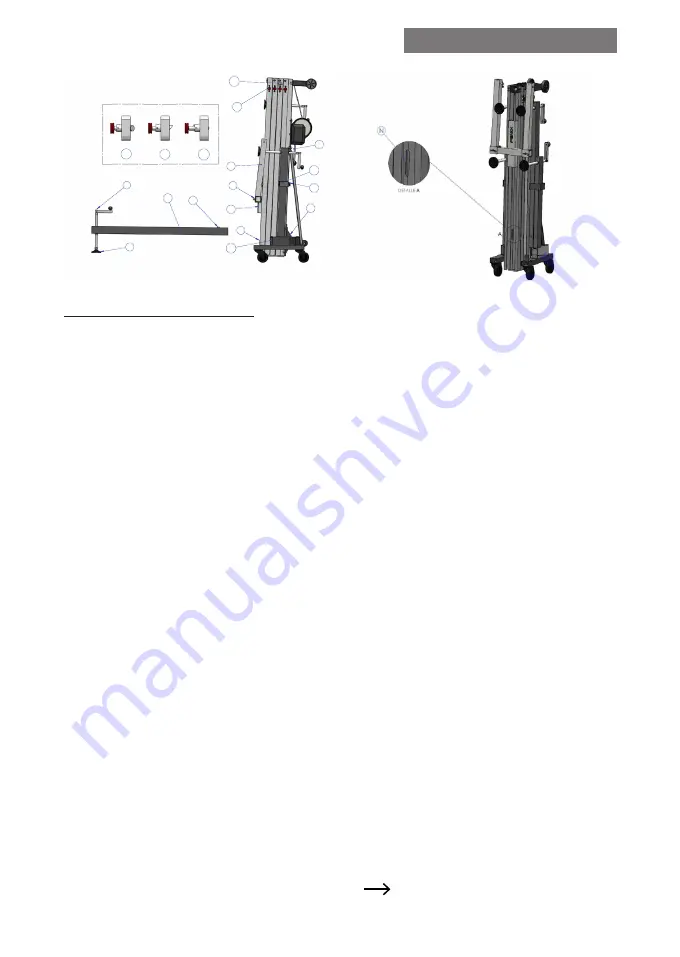
99
ESPAÑOL
4. INSTRUCCIONES DE USO
1. Colocar la torre elevadora sobre una su-
perficie plana y firme en su emplazamiento
de trabajo.
2. Sacar las patas (H) de su soporte para
transporte (C) liberando el pomo de plástico
(V) y estirar de la pata (H) hacia arriba. In-
sertarlas en sus alojamientos de trabajo (G)
comprobando que quedan sujetas por los ga-
tillos de seguridad (K). Las patas largas, de-
lante, bajo la carga.
3. Sacar el pasador (L) de la pletina de trans-
porte (F) y quitar el brazo de carga (E). Gi-
rar la manivela del cabestrante (B) hasta que
el carro (X) haya subido lo suficiente como
para que no toque con la pletina de transpor-
te (F). Poner los brazos de carga (E) en posi-
ción horizontal y asegurar con el pasador (L).
4. Insertar las patas (H) en sus alojamientos
de trabajo (G) comprobando que quedan
sujetas por los gatillos de seguridad (K). Las
patas largas, delante, bajo la carga.
5. Ajustar la torre elevadora utilizando los
platos de apoyo (J) girando la manivela (I) de
la varilla reguladora hasta que quede nivela-
da, observando el nivel de burbuja estabiliza-
dor (Y) de la base.
6. Colocar la carga que se va a elevar lo más
cerca posible de la torre elevadora. No sepa-
rar innecesariamente el equipo de sonido del
cuerpo de la torre elevadora para evitar una
sobrecarga. Ver fig. 2 (pág. 17). Seguir ins-
trucciones de carga. Ver fig. 3 (pág. 17).
7. Elevación: Para elevar los perfiles hay que
seguir un orden concreto. El primer perfil
que hay que subir siempre será el más aleja-
do del cabestrante. Liberar el gatillo de segu-
ridad (A) en posición abierta (T) y girar la
manivela del cabestrante (B) en el sentido de
las agujas del reloj elevando la carga hasta la
posición deseada. Inmediatamente después,
mover el gatillo de seguridad (A) en posición
cerrada (S), hasta que haya llegado al final
del tramo, y así sucesivamente entre las dis-
tintas posiciones de cada uno de los perfiles,
hasta llegar a la altura deseada. En el caso de
que el gatillo esté duro y sea difícil de sacar,
hay que realizar un pequeño juego con el ca-
bestrante hasta encontrar la posición exacta
donde se libere el gatillo y se pueda sacar có-
modamente. En ningún caso se deberá tirar
con fuerza de ninguno de los gatillos. En caso
de no elevar la torre elevadora hasta su altura
máxima, se recomienda subir todos los per-
files proporcionalmente acorde a la altura, y
no únicamente uno de ellos.
8. En caso de usar la torre elevadora al aire
libre, existe el riesgo de vientos, para lo cual
se ha previsto de dos argollas laterales de fi-
jación (M) situadas en la parte superior del
segundo perfil, donde deberán fijarse los
tensores que serán anclados a lugares firmes
y seguros (nunca sobre un vehículo o cual-
quier otro elemento que pueda desplazarse).
A partir de una velocidad de 30km/h es im-
prescindible bajar la torre elevadora.
9
S
A
C
J
G
M
B
X
I
H
V
K
F
Y
E
L
U
T
Содержание AT-06B
Страница 2: ...2 2 FENIX STAGE S L U Avda de los Trabajadores 24 Horno de Alcedo 46026 Valencia Spain ...
Страница 18: ...18 ...
Страница 19: ...19 ...
Страница 20: ...20 ...
Страница 21: ...21 ...
Страница 22: ...22 ...
Страница 23: ...23 NOTAS NOTES LIFTING TOWERS ...










































